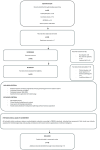The application of artificial intelligence in forensic pathology: a systematic literature review
- PMID: 40776925
- PMCID: PMC12328379
- DOI: 10.3389/fmed.2025.1583743
The application of artificial intelligence in forensic pathology: a systematic literature review
Abstract
Introduction: Recent advancements in Artificial Intelligence have shown immense potential across various domains of healthcare, including forensic pathology. This systematic review aims to evaluate the latest innovations brought by Artificial Intelligence in forensic pathology and provide insights into future directions in this evolving field.
Methods: A systematic literature search was conducted using databases for papers published from 1990 to 2025. The search strategy combined terms related to artificial intelligence, forensic odontology, forensic psychiatry and forensic medicine/pathology. Following PRISMA guidelines, 65 articles were initially identified, of which 18 met the inclusion criteria after applying exclusion criteria.
Results: Artificial Intelligence applications demonstrated significant success across multiple forensic domains. In post-mortem analysis, deep learning achieved 70-94% accuracy in neurological forensics. Wound analysis systems showed high accuracy rates (87.99-98%) in gunshot wound classification. Artificial Intelligence-enhanced diatom testing for drowning cases achieved precision scores of 0.9 and recall scores of 0.95. Microbiome analysis applications reached accuracy rates up to 90% for individual identification and geographical origin determination. AI shows promise in forensic age estimation, psychiatric risk assessment, and insanity evaluations.
Discussion: While Artificial Intelligence shows promise as a supportive tool in forensic pathology, several limitations persist, including small sample sizes and variable performance across different applications. Artificial Intelligence serves best as an enhancement rather than a replacement for human expertise. Future development should focus on larger datasets, specialized systems for different forensic applications, and improved interpretability of Artificial Intelligence decisions for legal contexts. The integration of Artificial Intelligence in forensic pathology represents a significant advancement, requiring careful balance between technological innovation and human expertise for optimal implementation.
Keywords: AI; artificial intelligence; bioethics; forensic medicine; forensic pathology.
Copyright © 2025 Orsini, Cioffi, Cipolloni, Bibbò, Montana, De Simone and Cecannecchia.
Conflict of interest statement
The authors declare that the research was conducted in the absence of any commercial or financial relationships that could be construed as a potential conflict of interest
Figures
References
-
- Karaboue MAA, Lacasella GV, Camilla C, Baldari B, Cipolloni L, De Simone S, et al. End-of-Life in Italy: critical and bioethical aspects of the bill on physician-assisted suicide: physician-assisted suicide in Italy. Medicina Historica. (2022) e2022026–e2022026.
Publication types
LinkOut - more resources
Full Text Sources
Miscellaneous


